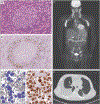HIV-Associated Cancers and Related Diseases
- PMID: 29539283
- PMCID: PMC6890231
- DOI: 10.1056/NEJMra1615896
HIV-Associated Cancers and Related Diseases
Abstract
Clusters of cases of pneumocystis pneumonia and Kaposi’s sarcoma in New York and California in men who had sex with men were early harbingers of the acquired immunodeficiency syndrome (AIDS) epidemic. The syndrome was also soon noted to be associated with a high incidence of aggressive B-cell lymphomas. As the AIDS definition crystallized, Kaposi’s sarcoma, aggressive B-cell lymphomas, and invasive cervical cancer were considered to be AIDS-defining cancers when they developed in patients with human immunodeficiency virus (HIV) infection. Additional cancers are now known to be associated with HIV (Table 1). The term HIV-associated cancer is used here to describe this larger group of cancers (both AIDS-defining and non–AIDS-defining cancers) that have an increased incidence among patients with HIV infection. In addition, incidental cancers also may develop in patients with HIV infection.
Figures



Comment in
-
HIV-Associated Cancers and Related Diseases.N Engl J Med. 2018 May 31;378(22):2144. doi: 10.1056/NEJMc1804812. N Engl J Med. 2018. PMID: 29847899 No abstract available.
-
HIV-Associated Cancers and Related Diseases.N Engl J Med. 2018 May 31;378(22):2144-5. doi: 10.1056/NEJMc1804812. N Engl J Med. 2018. PMID: 29847900 No abstract available.
References
-
- Kaposi’s sarcoma and Pneumocystis pneumonia among homosexual men — New York City and California. MMWR Morb Mortal Wkly Rep 1981; 30: 305–8. - PubMed
-
- 1993 Revised classification system for HIV infection and expanded surveillance case definition for AIDS among adolescents and adults. MMWR Recomm Rep 1992; 41(RR-17): 1–19. - PubMed
-
- Eltom MA, Jemal A, Mbulaiteye SM, Devesa SS, Biggar RJ. Trends in Kaposi’s sarcoma and non-Hodgkin’s lymphoma incidence in the United States from 1973 through 1998. J Natl Cancer Inst 2002; 94: 1204–10. - PubMed
Publication types
MeSH terms
Grants and funding
LinkOut - more resources
Full Text Sources
Other Literature Sources
Medical
Research Materials
